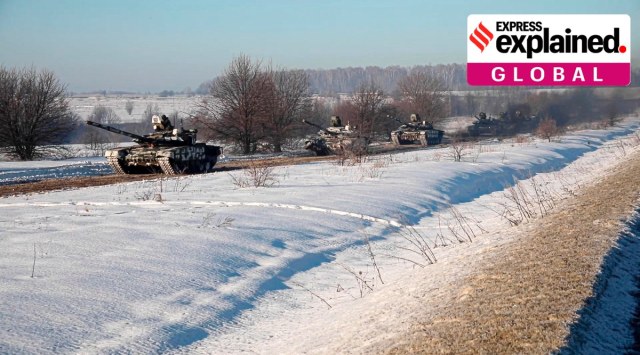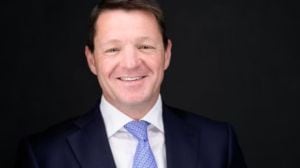An estimated 130,000 Russian troops are in position on Ukraine’s northern, eastern and southern sides.

What does this mean?
The announcement coming from Putin is the strongest signal from Russia that it is trying to de-escalate the situation that has led to the military standoff near the Ukrainian border.
This is the first sign that Russia might be pulling back from escalation, after weeks of brinkmanship with the West.
So, have the troops moved?
The Russian Defense Ministry Tuesday announced only the withdrawal of units from Russia’s Western and Southern Military Districts. Those districts are closest to Ukraine, and so the troops could be easily sent back to the border, if needed.
Story continues below this ad
The units from the Central and Eastern Military Districts, which are some of Russia’s most advanced, remain deployed, and in recent weeks have been positioned in attack formations, some within a few dozen miles of Ukraine’s border, according to satellite imagery.
Analysts say that even if Russia does pull back a significant number of units from the Western and Southern Military Districts, it will still have enough forces to launch serious military incursions, particularly from the north, in the direction of the Ukrainian city of Kharkiv, as well as from the Crimean Peninsula. There, Russia has built up a massive troop presence that includes attack aircraft and rapid response special forces and airborne units.
The Russian Navy alone has sufficient forces deployed in the Black Sea and Sea of Azov to mount a significant amphibious assault on the Ukrainian coast, including perhaps 2,000 troops and nearly 200 tanks and armored vehicles loaded onto six large landing craft deployed from Russia’s Baltic and Northern Fleets.
On Wednesday afternoon, Russia announced the end of Crimea military drills, and troops were leaving. “Russia says military drills in Moscow-annexed Crimea have ended and soldiers are returning to their garrisons, a day after it announced a first troop pullback from Ukraine’s borders. State television shows images of military units crossing a bridge back to the mainland,” AFP, the French news agency, reported.
Story continues below this ad
So, what’s the problem?
Military analysts caution that it is too premature to arrive at conclusions about a possible withdrawal of Russian forces without more information about which units are being sent back to their bases.
Ukraine’s foreign minister Dmytro Kuleba said there was reason to be skeptical of Moscow’s statements. “When we see the withdrawal, we will believe in de-escalation,” he said.
US officials said they were still assessing Russia’s troop announcement, and the NATO secretary general, Jens Stoltenberg, said that members of the alliance “have not seen any sign of de-escalation”. Russia has moved forces around before while leaving heavy weapons in place, Stoltenberg said.
Story continues below this ad
Experts are also sceptical and have raised questions whether it is a tactic, and whether these troops are being replaced or being rotated, since they have been deployed in cold weather for a long time.
So besides the military pullback, is there any other front being opened?
The websites of Ukraine’s defence ministry and army, as well as the interfaces of the country’s two largest banks, were hit by cyberattacks on Tuesday, a Ukrainian government agency said.
On Tuesday, clients of the state-owned PrivatBank and Oschadbank began to complain about difficulties using teller machines and mobile phone applications. The banks confirmed the attack, but said the funds in users’ accounts had not been affected, though users said they had been temporarily unable to withdraw money or use their credit cards. However, users reported by Tuesday evening that some services had been restored.
Experts say this could be another tactic to create panic among the Ukrainian establishment.
Story continues below this ad
 US Army troops arrive at the Rzeszow-Jasionka airport in southeastern Poland on Tuesday after President Joe Biden ordered the deployment amid fears of a Russian invasion of Ukraine. (AP Photo)
US Army troops arrive at the Rzeszow-Jasionka airport in southeastern Poland on Tuesday after President Joe Biden ordered the deployment amid fears of a Russian invasion of Ukraine. (AP Photo)
What has been the US response to Russia’s pullback announcement?
US President Joe Biden said on Tuesday that American officials had not verified Russia’s claim that it is pulling some troops back from Ukraine’s border, saying that Russian forces remain “very much in a threatening position” and that “an invasion remains distinctly possible.”

He added that Russia has more than 150,000 troops encircling Ukraine, a higher estimate than US officials had previously provided.
Speaking from the East Room of the White House, Biden vowed to “give the diplomacy every chance” to prevent a Russian invasion. But he also promised not to “sacrifice basic principles” according countries the right to determine the shape of their own borders.
Biden turned to public outreach to deter a Russian invasion of Ukraine. “To the citizens of Russia, you are not our enemy, and I do not believe you want a bloody, destructive war” with Ukraine, Biden said.
Story continues below this ad
The president said he had no intention of sending American troops to fight in Ukraine, which is not a member of the NATO alliance, but he noted that the US has provided military equipment, intelligence and training to Ukraine’s government as its prepares for any invasion.
“The United States will defend every inch of NATO territory with the full force of American power,” he said. “An attack against one NATO country is an attack against all of us.”
Newsletter | Click to get the day’s best explainers in your inbox



 US Army troops arrive at the Rzeszow-Jasionka airport in southeastern Poland on Tuesday after President Joe Biden ordered the deployment amid fears of a Russian invasion of Ukraine. (AP Photo)
US Army troops arrive at the Rzeszow-Jasionka airport in southeastern Poland on Tuesday after President Joe Biden ordered the deployment amid fears of a Russian invasion of Ukraine. (AP Photo)





































